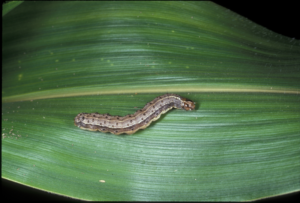Fall Armyworm
Fall armyworm (Spodoptera frugiperda) is an exotic pest that has been detected in Queensland.
Fall armyworm is reported to feed on more than 350 plant species, including maize, cotton, rice, sorghum, sugarcane, wheat, and vegetable and fruit crops, and have caused significant economic losses overseas.
Fall armyworm includes 2 subpopulations, or strains, that are morphologically indistinguishable but differ in their host plant preference and certain physiological features. Diagnosis by a laboratory is required to identify the strain.
Destruction of crops can happen rapidly when infestation levels are high.
Fall Armyworm egg mass
Pale yellow and clustered together in a mass.
An egg mass can contain 100–200 eggs.
Egg masses are usually attached to foliage in a mound, with a silk-like furry substance.
Fall Armyworm larvae
When larvae are newly hatched they are about 1.7mm, light green to brown with a larger, darker head.
As they develop, they become a darker greyish-brown with white lengthwise stripes and dark spots with spines on their upper surface, with a pale underside. Older larvae have a distinctive pattern of 4 spots on the second to last body segment and an inverted ‘Y’ shape pattern on their heads.
Eventually reach a length of about 34mm.
Fall Armyworm adult
Moth, 15–20mm with a 32–40mm wingspan.
Brown or grey forewing and a white hind wing.
Male fall armyworm moths have more patterns and a distinct white spot on each forewing.
Plant stage and plant parts affected
The larvae can affect leaves, shoots, stems and fruit. Plants of different ages, from seedlings to mature plants, can be affected.
Plant damage
Fall armyworm larvae initially feed on leaves, creating pinholes and windows in leaf tissue, and giving leaf margins a tattered appearance. In grass-like plants, they often feed within the leaf whorl (where leaves radiate from or wrap around the stem or stalk—see image 2). Insect frass (droppings) is a sign that larvae are present.
Fall armyworm larvae can also eat buds and tunnel into and feed on fruit. Larger larvae can cut plants off at the base.
Many larvae may be present on 1 plant. When they are found in large numbers, they can defoliate preferred host plants and acquire an ‘armyworm’ habit and disperse in large numbers. Crops have been reportedly been destroyed almost overnight.
This emergency permit has been issued by the Australian Pesticides & Veterinary Medicines Authority (APVMA):
Permit ID PER89241
Description Spinetoram (Success Neo or Delegate) / Fall Armyworm / Various Crops
Date Issued 6-Mar-20
Expiry Date 31-Mar-23
Permit holder Hort Innovation
Please follow all directions on the applicable Success Neo or Delegate label.
All efforts have been made to provide the most current, complete and accurate information on these permits, however we recommend that you confirm the details of these permits at the following APVMA website: APVMA PORTAL
A guide to preliminary sorting of trap catches from fall armyworm pheromone traps
This guide has been developed from experience in Queensland (March–May, 2020) with the fall armyworm (FAW) bucket traps equipped with the ChemTica pheromone lure to enable trap operators to distinguish the moths that are potentially FAW. Photographs and/or specimens can then be sent to an entomologist for more detailed examination
Unlike helicoverpa pheromone traps that only attract one species of moth, a considerable amount of the moths collected from the FAW traps have not been FAW. Basic sorting of obvious bycatch by the trap operator will reduce the volume of specimens that need to be examined more closely to determine whether FAW moths are present in the trap.





